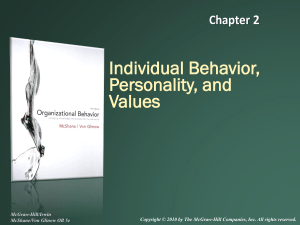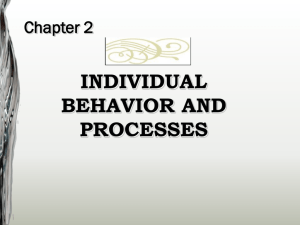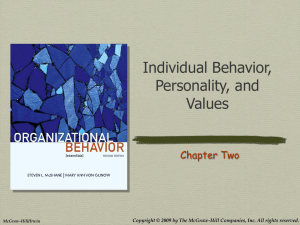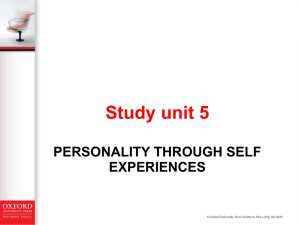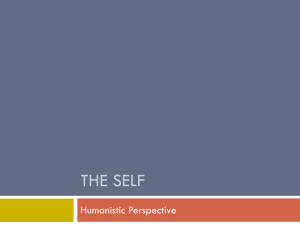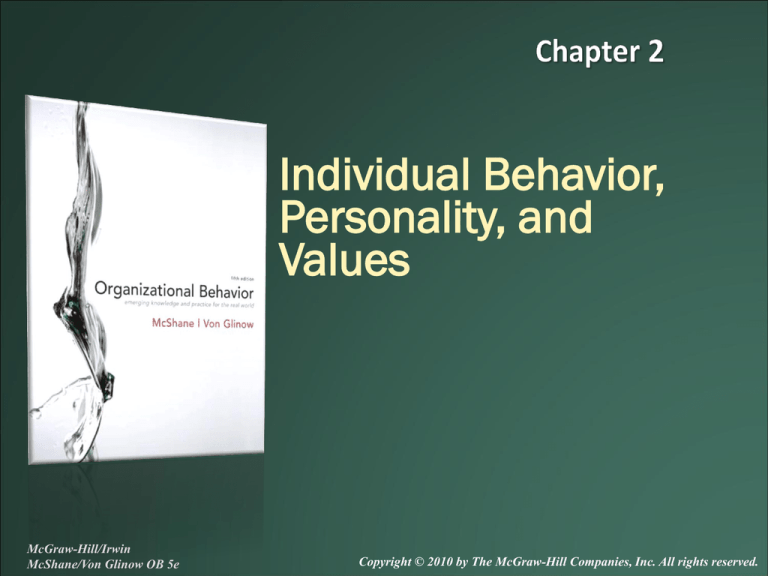
Individual Behavior,
Personality, and
Values
McGraw-Hill/Irwin
McShane/Von Glinow OB 5e
Copyright © 2010 by The McGraw-Hill Companies, Inc. All rights reserved.
Values, Personality, and Self-Concept at Fairmont
Hotels & Resorts
Fairmont Hotels & Resorts has
excelled as North America’s
largest luxury hotel operator by
hiring people such as Yasmeen
Youssef (shown here) with the
right values and personality
and then nurturing their selfconcept.
YasmeenYoussef
Fairmont Hotels & Resorts
2-2
MARS Model of Individual Behavior
Situational
factors
Values
Motivation
Personality
Perceptions
Emotions
Ability
Individual
behavior and
results
Attitudes
Stress
Role
perceptions
2-3
The Basic Psychological Model
Behavior = function (Person,
Environment)
Law of Effect = future behavior
is a function of it’s past
consequences
McShane/Von Glinow OB 5e
4
© 2010 The McGraw-Hill Companies, Inc. All rights reserved
Employee Motivation
Internal forces that affect a person’s
voluntary choice ofbehavior
• direction
• intensity
• persistence
S
M
A
BAR
R
2-5
Employee Ability
Natural aptitudes and learned capabilities
required to successfully complete a task
Competencies personal characteristics that
lead to superior performance
Person job matching
• selecting
• developing
• redesigning
S
M
A
BAR
R
2-6
Role Perceptions
Beliefs about what behavior is required to
achieve the desired results:
• understanding what tasks to perform
• understanding relative importance of tasks
• understanding preferred
behaviors to accomplish tasks
S
M
A
BAR
R
2-7
Situational Factors
Environmental conditions beyond the
individual’s short-term control that constrain
or facilitate behavior
• time
• people
• budget
• work facilities
S
M
A
BAR
R
2-8
Defining Personality
Relatively enduring pattern of thoughts,
emotions, and behaviors that characterize a
person, along with the psychological
processes behind those characteristics
• External traits – observable behaviors
• Internal states – thoughts, values, etc inferred from
behaviors
• Some variability, adjust to suit the situation
2-9
Nature vs. Nurture of Personality
Influenced by Nature
• Heredity explains about 50 percent of behavioral
tendencies and 30 percent of temperament
• Minnesota studies – twins had similar behaviour
patterns
Influenced by Nurture
• Socialization, life experiences, learning also affect
personality
• Personality isn’t stable at birth
• Stabilizes throughout adolescence
• Executive function steers using our self-concept as
a guide
2-10
Five-Factor Personality Model
(CANOE)
Conscientiousness
Careful, dependable
Agreeableness
Courteous, caring
Neuroticism
Anxious, hostile
Openness to Experience
Sensitive, flexible
Extroversion
Outgoing, talkative
2-11
Five-Factor Personality and
Organizational Behavior
Conscientiousness and emotional stability
• Motivational components of personality
• Strongest personality predictors of performance
Extroversion
• Linked to sales and mgt performance
• Related to social interaction and persuasion
Agreeableness
• Effective in jobs requiring cooperation and helpfulness
Openness to experience
• Linked to higher creativity and adaptability to change
2-12
Common Personality Measures
MMPI – Minnesota Multiphasic Personality Inventory
measures “emotional stability” on 10 scales
http://psychology.about.com/od/psychologicaltesting/a/mmpi_2.htm
MBTI – Meyers Briggs Type Indicator
CPI – California Psychological Inventory
HPI - Hogan Personality Inventory
McShane/Von Glinow OB 5e
13
© 2010 The McGraw-Hill Companies, Inc. All rights reserved
MBTI at Southwest Airlines
Southwest Airlines uses the
Myers-Briggs Type Indicator to
help staff understand and
respect co-workers’ different
personalities and thinking styles.
“You can walk by and see
someone's [MBTI type] posted
up in their cube,” says Elizabeth
Bryant, Southwest’s leadership
development director (shown
here).
2-14
Jungian Personality Theory
Swiss psychiatrist Carl Jung
Identifies preferences for
perceiving the environment
and obtaining/processing
information
Commonly measured by
Myers-Briggs Type Indicator
(MBTI)
2-15
Myers-Briggs Type Indicator (MBTI)
Extroversion versus introversion
• similar to five-factor dimension
Sensing versus intuition
• collecting information through senses versus
through intuition, inspiration or subjective sources
Thinking versus feeling
• processing and evaluating information
• using rational logic versus personal values
Judging versus perceiving
• orient themselves to the outer world
• order and structure or flexibility and spontaneity
2-16
Feeling Valued at Johnson & Johnson
Johnson & Johnson is one of the most
respected employers because it recognizes
the value of supporting each employee’s selfconcept
2-17
Self-Concept Defined
An individual’s self-beliefs and self-evaluations
“Who am I?” and “How do I feel about myself?”
Guides individual decisions and behavior
2-18
Three “C’s” of Self-Concept
Complexity
• People have multiple self-concepts
Consistency
• Improved wellbeing when multiple self-concepts
require similar personality traits and values
Clarity
• Clearly and confidently described, internally
consistent, and stable across time.
• Self-concept clarity requires self-concept
consistency
2-19
Four “Selves” of Self-Concept
Self-enhancement
• Promoting and protecting our positive self-view
Self-verification
• Affirming our existing self-concept (good and bad
elements)
Self-evaluation
• Evaluating ourselves through self-esteem, self-
efficacy, and locus of control
Social self
• Defining ourselves in terms of group membership
2-20
Self-Concept: Self-Enhancement
Drive to promote/protect a positive self-view
• competent, attractive, lucky, ethical, valued
Strongest in common/important situations
Positive self-concept outcomes:
• better personal adjustment and mental/physical
health
• inflates personal causation and probability of
success
2-21
Self-Concept: Self-Verification
Motivation to verify/maintain our existing selfconcept
Stabilizes our self-concept
People prefer feedback consistent with their
self-concept
Self-verification outcomes:
• We ignore or reject info inconsistent with self-
concept
• We interact more with those who affirm/reflect selfconcept
2-22
Self-Concept: Self-Evaluation
Defined mainly by three dimensions:
Self-esteem
• High self-esteem -- less influenced, more
persistent/logical
Self-efficacy
• Belief in one’s ability, motivation, role perceptions, and
situation to complete a task successfully
• General vs. task-specific self-efficacy
Locus of control
• General belief about personal control over life events
• Higher self-evaluation with internal locus of control
2-23
Self-Concept: Social Self
Social identity -- defining ourselves in terms of
groups to which we belong or have an emotional
attachment
We identify with groups that have high status -- aids
self-enhancement
Contrasting Groups
IBM Employee
Live in
U.S.A.
An individual’s
social identity
University of Dallas
Graduate
Employees at
other firms
People living in
other countries
Graduates of other
schools
2-24
Values in the Workplace
Stable, evaluative beliefs that guide our
preferences
Define right or wrong, good or bad
Value system -- hierarchy of values
2-25
Schwartz’s Values Model
2-26
Schwartz’s Values Model
Openness to change – motivation
to pursue innovative ways
Conservation -- motivation to
preserve the status quo
Self-enhancement -- motivated by
self-interest
Self-transcendence -- motivation to
promote welfare of others and
nature
2-27
Values and Behavior
Habitual behavior usually consistent with
values, but conscious behavior less so
because values are abstract constructs
Decisions and behavior are linked to values
when:
• Mindful of our values
• Have logical reasons to apply values in that
situation
• Situation does not interfere
2-28
Values Congruence
Where two or more entities have similar
value systems
Problems with incongruence
• Incompatible decisions
• Lower satisfaction/loyalty
• Higher stress and turnover
Benefits of incongruence
• Better decision making (diverse perspectives)
• Avoids “corporate cults”
2-29
Values Across Cultures: Individualism
and Collectivism
Degree that people value duty to their group
(collectivism) versus independence and
person uniqueness (individualism)
Previously considered opposites, but
unrelated -- i.e. possible to value high
individualism and high collectivism
2-30
Individualism
High Individualism
U.S.
Italy
India
Denmark
The degree to which people
value personal freedom,
self-sufficiency, control over
themselves, being
appreciated for unique
qualities
Taiwan
Low Individualism
2-31
Collectivism
High Collectivism
Italy
Taiwan
The degree to which people
value their group
membership and
harmonious relationships
within the group
India
Denmark
U.S.
Low Collectivism
2-32
Power Distance
High Power Distance
Malaysia
• Value obedience to authority
Venezuela
• Comfortable receiving
commands from superiors
• Prefer formal rules and authority
to resolve conflicts
Japan
U.S.
Denmark
Israel
Low Power Distance
High power distance
Low power distance
• Expect relatively equal power
sharing
• View relationship with boss as
interdependence, not
dependence
2-33
Uncertainty Avoidance
High U. A.
Greece
Japan
• feel threatened by ambiguity
and uncertainty
• value structured situations and
direct communication
Italy
U.S.
High uncertainty avoidance
Low uncertainty avoidance
• tolerate ambiguity and
uncertainty
Singapore
Low U. A.
2-34
Achievement-Nurturing
Achievement
Japan
High achievement
orientation
• assertiveness
• competitiveness
China
U.S.
France
Chile
• materialism
High nurturing orientation
• relationships
• others’ well-being
Sweden
Nurturing
2-35
Three Ethical Principles
Utilitarianism
Individual
Rights
Distributive
Justice
Greatest good for the greatest number
of people
Fundamental entitlements
in society
People who are similar should receive
similar benefits
2-36
An Alternative Set of Principles
Egoist – if it benefits me
Utilitarian – “the greatest net
good”
Absolutist – right and wrong
stand apart from human
judgment
McShane/Von Glinow OB 5e
37
© 2010 The McGraw-Hill Companies, Inc. All rights reserved
Influences on Ethical Conduct
Moral intensity
• degree that issue demands ethical principles
Ethical sensitivity
• ability to recognize the presence and determine the
relative importance of an ethical issue
Situational influences
• competitive pressures and other conditions affect
ethical behavior
2-38
Supporting Ethical Behavior
Ethical code of conduct
Ethics training
Ethics hotlines
Ethical leadership and culture
Individual Behavior,
Personality, and
Values
McGraw-Hill/Irwin
McShane/Von Glinow OB 5e
Copyright © 2010 by The McGraw-Hill Companies, Inc. All rights reserved.
2-40


